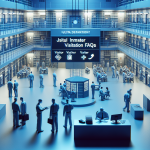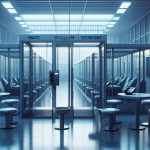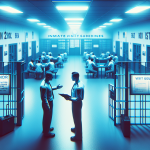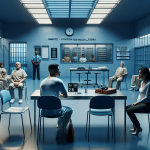Visiting an inmate at the Western Region Detention Facility (WRDF) in San Diego can be a rewarding experience for both parties. To help keep all visits safe and secure, the WRDF has created a protocol outlining the steps for inmate visitation.
The first step is to fill out the appropriate application. This application must be filled out before any visitation is granted. The WRDF also has strict guidelines about what items are allowed to be brought to the visit, so be sure to check those before attending.
Once approved, visitation dates are assigned. Visitation times can be booked up to two weeks in advance. Saturday and Sunday visits are scheduled in the morning, while weekday visits are scheduled in the afternoon. The WRDF only allows for a maximum of two visitors at a time, so plan accordingly.
It’s also important to note that visitors must report to the visitor registration desk at least thirty minutes before the listed visitation time. All visitors must be on the approved visitation list and present valid picture identification.
During the visit, all visitors must remain seated and cannot interact with any inmates. All visitors is also prohibited from bringing any food or drink into the visiting area.
The WRDF offers added iterable for those who cannot make it to the facility in person. Video visitation is available for up to thirty minutes and can be requested online through the WRDF’s website. This is the perfect alternative for those who don’t or cannot make it to the facility in person.
Overall, these visitation protocols are designed to ensure a safe and secure environment for everyone. Follow these rules and guidelines for a smooth and successful visit.
Western Region Detention Facility at San Diego – Overview and Information
The Western Region Detention Facility at San Diego is a detention center operated by the US Immigration and Customs Enforcement (ICE). It is located in Otay Mesa, San Diego, California, and is the largest Immigration and Customs Enforcement (ICE) detention facility in California. It has the capacity to hold up to 1,228 detainees.
The Western Region Detention Facility is a high security facility and holds both criminal and immigration detainees for ICE. It is a temporary detention facility, so it normally holds individuals for less than 180 days, while longer term housing may be arranged at other ICE facilities.
The facility is an important part of ICE’s effort to ensure the expulsion and timely detention of immigration violators who are found in the United States, as well as to facilitate removal proceedings for individuals who are subject to repatriation.
The facility offers amenities such as a full kitchen, dining area, library, chapel, recreation room, and a medical clinic staffed by a full-time doctor and nurses. Detainees have access to education, English language classes, vocational training, and recreational activities.
To ensure the safety of everyone in the facility, ICE has taken a number of security measures such as placing additional guards at the facility, installing security cameras, and installing an intercom system that links the facility to the main ICE office in San Francisco.
In addition to a security presence, ICE ensures the humane treatment of all individuals being housed at the Western Region Detention Facility by providing access to legal representation if needed, providing quality medical and mental health care services to individuals in detention, and providing activities for mental health and recreational purposes.
The Western Region Detention Facility is managed by dedicated and professional staff who are committed to providing a safe and secure environment for all of its occupants. The staff is held to the highest of standards and is dedicated to the humane treatment of all detainees.
Western Region Detention Facility at San Diego – Classes, Services, and Programs
Western Region Detention Facility at San Diego provides multifaceted services, classes, and programs to serve its residents. These programs encompass educational, vocational, religious, medical health, and recreational services.
Inmates are offered GED preparation classes, art classes and even college classes, where they can earn a college degree. They can participate in religious services from many denominations, including Muslim, Christian, and Jewish. These services also allow for prayer and meditation time.
The medical health services provide onsite medical facilities, staffed by medical professionals. This includes help with physical mental health problems, chronic illnesses, and emergency medical services.
Educational programs include tutoring, English as a Second Language (ESL) classes, computer classes, and an employment program to prepare inmates for employment upon release.Additionally, inmates are able to take part in recreational activities and sports like basketball and volleyball. Inmates can participate in structured activities such as bingo, board games, and educational activities.
One of the more unique programs offered at Western Region Detention Facility are the alcohol and drug education programs. These programs are developed for inmates who may have substance abuse issues, to enable them to break the cycle of addiction upon release.
The Western Region Detention Facility also provides access to a library, where inmates can borrow books and take part in book clubs. This library also has computers where inmates can access the internet, with supervised access. Other services include a volunteer program, where inmates can help in the facility and in the community.
All of these programs, classes, and services at the Western Region Detention Facility at San Diego are designed to help prepare inmates to be successful upon their release.
Inmate visiting application in Western Region Detention Facility at San Diego
In order to visit an inmate at the Western Region Detention Facility in San Diego, potential visitors must submit a completed Inmate Visiting Application form.
To begin, the potential visitor must provide identifying information about himself or herself at the top of the application, such as full legal name, address, phone number, driver license number, date of birth, and employer information (if any). This will allow the facility to properly identify and track any past or current visits.
Next, the potential visitor must provide information about the inmate or inmaites being visited, such as full name, booking number, housing location, and date of birth.
Once the identify information is filled out, the visitor must choose one of the three categories of visiting that are offered: social (for general visits with family), church (for religious visits with clergy, including volunteer ministers), or attorney visits (for visits with attorneys or persons representing an attorney).
The final sections of the application involve additional background questions and, if necessary, an approved list of visitors and attendants for requested visits with minors. The prison staff will review and approve such applications, and may require additional information to be provided by the potential visitor.
Once the application is filled out and all information is provided, the potential visitor must sign and date the application and submit it in person at the facility for approval. This process can take up to ninety days to complete.
Once the application is submitted and approved, the potential visitor will be given an identification card and additional information about the visitation process, such as regulations regarding what can and cannot be brought into the facility. The visitor must bring the identification card on the day of the visit, and all visitors will be subject to additional rules and regulations outlined by the facility.
For any other questions, visitors should contact the facility for more information.
Western Region Detention Facility at San Diego: Frequently Asked Questions and Answers
The Western Region Detention Facility (WRDF) is a medium and maximum security detention facility in San Diego, California. It serves as an administrative center for the Southern California criminal justice system. This facility houses over 1,000 inmates, so it’s important to understand the rules and regulations of WRDF and the resources available to inmates and their families.
Q: What services are offered at the WRDF?
A: The facility offers a variety of services including medical and mental health treatment, educational and vocational training, work-release, and religious programming. In addition, there are various recreational and social events throughout the year.
Q: What are the visiting hours at WRDF?
A: Visiting hours are generally from 8 am to 5 pm on weekdays and 8 am to 12 pm on weekends, except on holidays. Visitors should plan on arriving at least 15 to 20 minutes before their visit to check in.
Q: How can I stay in contact with an inmate at WRDF?
A: Inmates are allowed to make phone calls on their own, so you can contact them directly. There is also an inmate mail system, as well as kiosks that inmates can use to stay in touch with friends and family outside of the facility.
Q: How is security at the WRDF?
A: The security at WRDF is tight and monitored 24 hours a day. All visitors and staff are screened upon arrival and must pass through a metal detector before gaining entry. Any contraband items will be confiscated and the inmate or visitor in possession of them will face charges.
Q: Is there transportation available for inmates and visitors?
A: WRDF does not provide transportation for inmates or visitors. If you are coming to visit an inmate, you must arrange your own transportation.
Q: Are there any programs for inmates and visitors?
A: Yes, WRDF offers a variety of programs for inmates and their families. These include parenting classes, parenting support, substance education, and counseling. In addition, there are special programs such as art classes, academic and vocational courses, religious programming, and recreational activities.
Q: What other resources can I access while visiting WRDF?
A: WRDF also provides access to legal services, library services, spiritual services, and case management services. There is also an official website with additional information about the facility and






